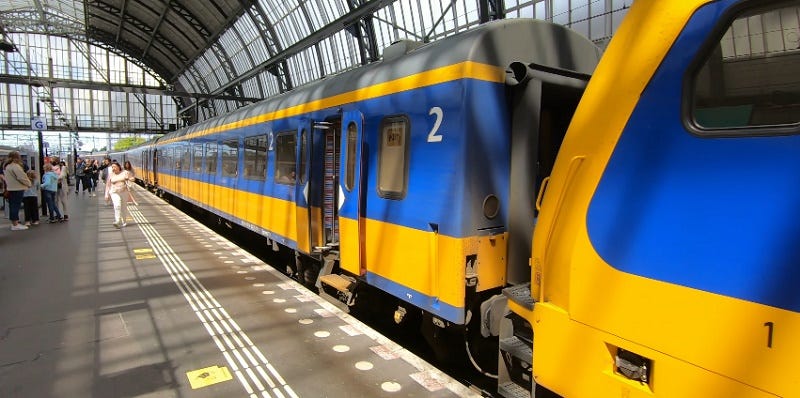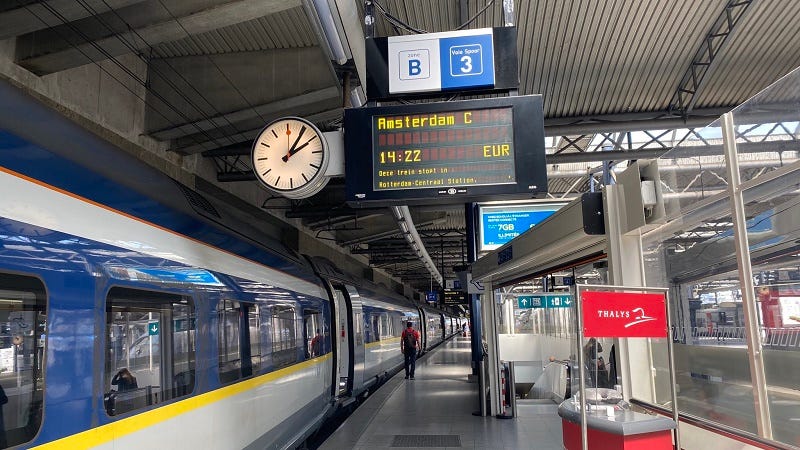The Railway Network in the Netherlands – A Current Overview
AndyBTravels discusses the Dutch railway network and train travel in the Netherlands
Trains in the Netherlands are frequent and – from an outsider’s perspective – reliable. Overall, the network is excellent.
For #AllTheLinesEurope – a project in which I aim to travel on every railway line with scheduled passenger services – I travelled on every line in the Netherlands, and I can say I never really experienced any significant problems on my frequent train trips to the country.
Of course, that does not mean everything is perfect, as there are aspects of the Dutch system that are rather odd and could be improved.
About the Dutch railway network
I think the Dutch are very fortunate to have such a dense railway network, connecting all urban areas and most of the countryside with frequent trains.
Because train services in the Netherlands are so frequent – on some of the main lines there is a departure every 10 to 15 minutes – it almost feels as if there are no timetables from a passenger’s perspective. Travelling on these routes is like using the metro in a big city – you simply turn up at the station and take the next train without checking the departure times beforehand.
This is particularly true in the Randstad – the conurbation in the central Netherlands centred around Amsterdam, The Hague, Rotterdam, and Utrecht – where trains operate as a true turn-up-and-go service. The level of service is approaching that of Japanese cities such as Tokyo and Osaka.

My Dutch rail adventures
Completing the Netherlands for #AllTheLinesEurope was actually quite easy, thanks to the frequent services. It was one of the first countries I completed when I started #AllTheLines, as it is so accessible from the UK. You can easily hop over for a weekend and cover quite a few lines.
Moreover, there are no obscure railway lines in the Netherlands. It does not suffer from the French problem of sparse services, with perhaps only one or two trains per day on a given line. Everything is well connected and efficient.
The scenery is not particularly stimulating when travelling by train around the Netherlands, but it does have its charms, with canals, windmills, and old-world towns visible from the train. However, I would not say the Netherlands is a must-visit for scenic highlights. Dutch trains are primarily a means of getting from A to B.
Rail competition
The NS – short for Nederlandse Spoorwegen (Dutch Railways) – is the national train operator in the Netherlands. However, some branch lines are operated by private companies, such as Arriva.
A number of branch lines in the Netherlands are franchised in a system similar to that in the UK, where operators can bid to run services for a set period, with the government ultimately awarding the contract based on price and quality. However, because the Netherlands has such a dense railway network, the authorities do not consider it feasible to allow competition on the main lines. The Netherlands has in fact been taken to the European Court of Justice by the European Commission over its refusal to open the entire railway network to competition.
The Dutch argue that introducing competition on the heavily used main lines would risk disintegrating the national network and undermining both network coherence and service quality.
There is some merit in the Dutch argument, in my view. Take, for example, the line from Utrecht to Eindhoven, which is operated to such a saturation point that there is no room for a new entrant. Introducing a new operator could actually disrupt the system, cause confusion, or increase unreliability. In effect, the turn-up-and-go service would be lost, as tickets would likely only be valid with the operator you purchased them from, rather than on any train along the route.
I fully understand the Dutch perspective, even though I am a strong supporter of open-access operators. However, I do not believe there is room for them on the domestic Dutch market, although they would be a great addition on international routes to and from the Netherlands.
NS trains
Every country tends to view other countries’ trains through rose-tinted glasses while criticising every aspect of their own railway network, overlooking the positives. The same applies in the Netherlands, where many people enjoy complaining about the NS.
Overall, I think the NS does a good job in terms of reliability and coverage, but it is not without flaws. They are very lax when it comes to the soft product on board their trains – particularly cleanliness. However, it is ultimately the government’s responsibility to set standards and hold NS accountable. In practice, though, this makes little difference, as there is no alternative operator to compete with or compare against them, and a state fining a state-owned company would seem rather odd.
Would this improve if a private operator directly competed with NS? Perhaps. But I think doing so would likely create more problems than it solves.
But ultimately, train cleanliness is a societal issue. It needs to be addressed promptly, because if trains are not kept clean and tidy, it can create a vicious cycle of decline – I would even invoke the broken windows theory. Travelling in the evenings or at quieter times, being in a neglected environment, it can all create a feeling of insecurity and may encourage more antisocial behaviour. That said, the Netherlands is not alone in this, as similar problems can be observed in Belgium and the UK, as I have discussed before.
Dutch railway stations
One of the more significant changes to the Dutch railway network in recent years has been at station level, with almost all stations now being gated, requiring passengers to tap in and out to pass through the barriers.
On the plus side, you can now also do this with your debit or credit card, with the fare automatically deducted from your account. If this reduces the number of people travelling without a ticket, it is a major positive. This goes beyond simply maximising revenue. Again, referring to the broken windows theory, if someone is travelling without a ticket – which is a criminal act – what other criminal behaviour might they engage in? Do you want such people sitting next to you on a train?
Gated stations can have downsides as well, as they may result in train attendants checking tickets less often and reduce their visible presence on board. This can also lead to passengers with second-class tickets sitting in first class. From what I have heard from Dutch people, this does seem to happen more frequently.
Leaving aside the discussion about ticket barriers, there is much to like about Dutch stations. Some older stations, such as Amsterdam Centraal, as well as newly renovated or constructed ones like Rotterdam Centraal, are very beautiful. It is also worth noting that almost all Dutch stations are fully accessible!
Tap in, tap out
Although it’s great that you can now use your debit or credit card to tap in and out at station gates, there is a little quirk passengers need to be aware of. If you need to connect on your journey to a train of another operator – for example, if you’re connecting from an NS to an Arriva train – you need to use your card four times: tap in at your starting point with NS, tap out with NS and tap in with Arriva at the connecting station, and tap out again at your destination with Arriva, rather than doing it only at the start and end point of your journey.
This is overly complicated and a significant downside – especially for foreign travellers and infrequent users – and it could surely be simplified in a national system where you only tap in once to check in and once to check out, with the system automatically taking the total fare from your card and allocating it between the operators used. Tap-in, tap-out should provide a seamless travel experience, and this does not.
International railway links
Weirdly enough, most international visitors’ first experience with Dutch trains will not be an international service, but the Amsterdam airport train linking Schiphol Airport to Amsterdam Centraal. With eight trains per hour and an easy tap-in, tap-out system, this is as good as airport connections get and makes a great introduction to trains in the Netherlands.
Of course, the Netherlands also has proper international train services, such as the Eurostar linking Amsterdam and Rotterdam to London. One of Eurostar’s best innovations has been the introduction of through trains to the Netherlands. London to Amsterdam is one of the busiest air routes in Europe, and this service now provides some competition between airlines and rail. I would love to see a competing operator on the London–Amsterdam route, as Eurostar has a monopoly, is no longer particularly innovative, and charges relatively high fares. The same applies to the Eurostar (formerly Thalys) high-speed service between Amsterdam and Paris.
Just a thought: trains have been reintroduced on the classic route between Brussels and Paris, competing with Eurostar on the high-speed line. Why not extend some of these services to Amsterdam? Or imagine returning to the days of the Trans-Europe Express (TEE) and reinstating a legendary train like the Étoile du Nord, complete with a dining car. Would such a service be successful today, or are passengers more concerned with travel time than with service levels or the unique experience? I can imagine quite a few people would welcome it!
Trains to Belgium and Germany




